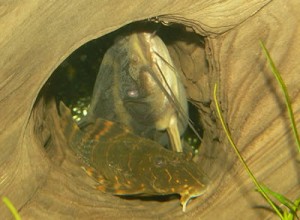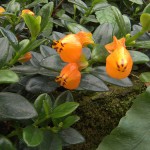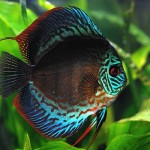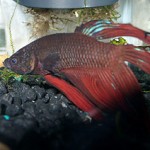Pleco is a name used for a wide range of different catfishes in the family Loricariidae and it is therefore impossible to provide any pleco care guidelines that will be true for all sorts of plecos. Always try to find out which species of pleco you are keeping, or at least to which genera it belongs. Unfortunately, this is sometimes really tricky and many fish stores have no idea of what they are actually selling. The name “Common pleco” is for instance used for a long row of different pleco species, such as Bristlenose Catfish ( Ancistrus dolichopterus ), Suckermouth Catfish ( Hypostomus plecostomus ), Sailfin Catfish ( Liposarcus multiradiatus ) and Amazon sailfin catfish ( Liposarcus pardalis ).
The species sold under the name “Common pleco” will normally have similar requirements and we will in this article focus on the needs of these plecos. If you keep some other type of pleco, the safest choice is to try to find species (or at least genus) specific information instead.
Temperament, habits and suitable tank mates
The species sold under the name Common pleco are normally territorial and should ideally not be kept together unless they are very small and live in a big aquarium. Many aquarists have successfully managed to house several Common plecos together, but it is risky. The temperament of the fishes can change as they grow older and bigger. It is probably safer to combine plecos from different species than sticking to a single species. You can also decrease the risk of territorial fights by using aquarium decorations to form several distinct territories in the aquarium.
The popular Bristlenose catfish ( Ancistrus dolichopterus ) is friendlier than the other “Common pleco”-species and keeping several Bristlenose catfishes together is usually not a problem, not even when they grow really large.
The species normally sold under the name Common pleco are nocturnal and prefers to rest in a sheltered spot during the day. They have a specialized omega iris which makes it possible for their eyes to block out the daylight. Since the “Common pleco”-species are nocturnal, you need to combine then with day-active species if you want your aquarium to be lively during the day. The Common pleco can be housed with most types of non-aggressive fish species, as long as you avoid fat och flat bodied fishes like goldfish and discus. The Common pleco can cause injury to such fishes by sucking on them.
If your Common pleco swims up to the surface once in a while to gulp down some air, its nothing to worry about. The pleco uses air to adjust its buoyancy and the gulping is not a sign of illness or a low oxygen level.
The Common pleco is an agile jumper and the aquarium must therefore be fitted with a secure lid. Without a lid, your pleco might try to jump out of the aquarium in search of a new larger or better home. This is a natural behaviour that makes it possible for the plecos to find new homes during the dry season. The Common pleco can absorb some oxygen from the air and is therefore capable of wiggling its way over a dried out river bed or similar in search of deeper waters. This ability to absorb oxygen from the air also what makes it possible for the Common pleco to survive somewhat longer than most other fishes if it jumps out and lands on the living room floor.
Aquarium for Common pleco
Aquarium size
Many aquarists routinely purchase Common pleco from the fish store in order to combat algae growth in the aquarium, but if you have a small aquarium the Common pleco is not a very wise choice since these fishes can reach a length of 30-60 cm (1-2 feet). They are normally sold when they are no bigger than 5-10 cm (2-4 inches) but they will grow bigger each year and will eventually outgrow a small aquarium. Be prepared to house your Common pleco in at least 200-375 litres of water (around 50-100 gallons). How old a pleco can become remains unknown, but the maximal lifespan in captivity is believed to be at least 20 years – provided of course that the fish is given suitable pleco care.
Aquarium decoration
Decorating the aquarium is an important part of proper pleco care. A barren aquarium is not recommended since such an aquarium can make the fishes shy and stressed. The pleco needs safe spots in the aquarium where it can rest during the day. Wood should always be included in the set up, since the Common pleco needs to chew on wood. In addition to wood, hiding spots and territorial borders can be created using all sorts of aquarium decorations, e.g. caves, stones, flower pots and artificial plants. Including live plants in the aquarium is risky, because the Common pleco might uproot or eat them. If you really want to use live plants, choose sturdy and fast growing species like java moss and java fern. It is also important to keep your pleco well fed and give it plenty of vegetables to feast on instead of plants.
Water parameters
Keep the water temperature in the 20-28 degrees C (68-82 degrees F) range and the pH-value between 6.0 and 7.5. The Common pleco appreciates soft water. Since this fish is lives in rivers and streams, it will prefer an aquarium with water movements and high levels of oxygen. Changing 30-50% of the water each week is a good rule of thumb, but you might have to adjust it to fit your particular aquarium. Regularly vacuum up faeces and left over food.
Pleco food
The Common pleco is a skilled algae eater but it should not be forced to live on natural algae growth only in the aquarium. It is an omnivore species that needs a lot of algae based food and vegetables combined with small and infrequent servings of meaty food. You must also place at least one peace of wood in the aquarium, since the Common pleco needs to be able to chew wood to stay healthy.
You can use algae based prepared food as a base and supplement with cucumber, zucchini, lettuce, green peas and similar. Larger plecos can be given a shrimp or similar once in a while and smaller plecos can be served cut up shrimps, earthworms etc. Always make sure that your pleco actually gets some food; in some aquariums fast and day active species gulp down all the food and leave nothing for the plecos.

















Leave a Reply